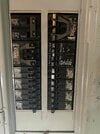Hi Everyone! I’ve recently moved into an older home built about 25-30 years ago and have recently purchased a Tesla model 3 performance which I’m still awaiting delivery for.
I am worried about the feasibility of a Nema 14-50 outlet given my older home and 150 AMP circuit box. The good news is that my Stove / water heater is operated by primarily gas and not electricity. However, I do have two ac units, washer, dryer, microwave, stove, and dishwasher operating from electricity. I’ve attached photos of the circuit breaker.
did anyone else have a similar scenario find a solution that didn’t require upgrading the entire circuit to 200 or 250 amps? I could get away with a nema 14-30 outlet worst case given my driving needs.

I am worried about the feasibility of a Nema 14-50 outlet given my older home and 150 AMP circuit box. The good news is that my Stove / water heater is operated by primarily gas and not electricity. However, I do have two ac units, washer, dryer, microwave, stove, and dishwasher operating from electricity. I’ve attached photos of the circuit breaker.
did anyone else have a similar scenario find a solution that didn’t require upgrading the entire circuit to 200 or 250 amps? I could get away with a nema 14-30 outlet worst case given my driving needs.





